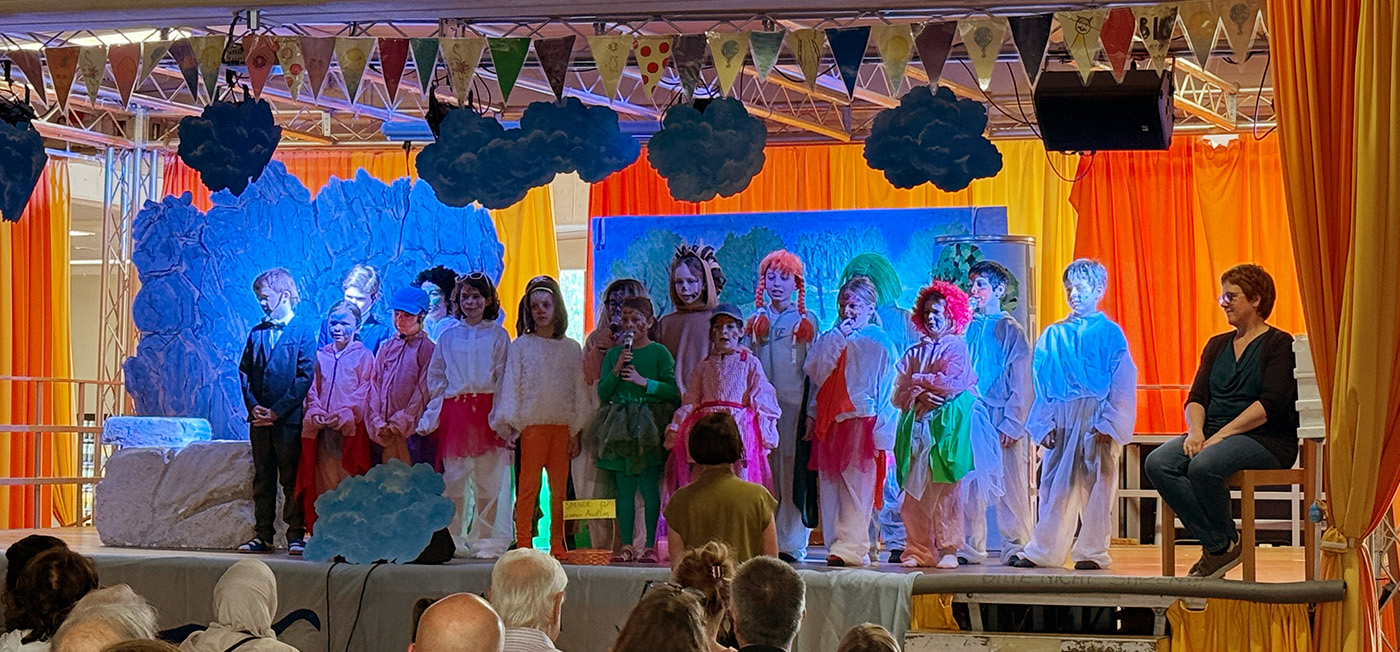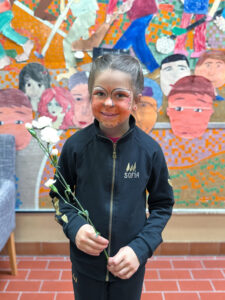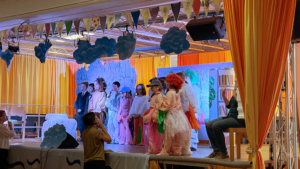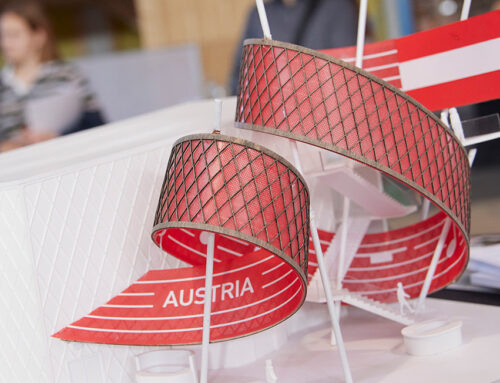With cochlear implants on her way to the stage
Sofia Weber was born deaf, but thanks to her double-sided (bilateral) cochlear implants she can hear and understand in three languages. In May, the seven-year-old played the title role in her school class’s musical performance.

“Here comes the little dragon Coconut!” echoes from the stage.
The second-grade inclusion class at the Federal Institute for the Education of the Deaf — or BIG for short — sings and performs The School Festival on the Fire Rock for their parents and siblings. Two boys take turns reading the long narration parts. Also on stage is seven-year-old Sofia Weber, who plays the little dragon Coconut and lends him her bright voice.
Unlike his fellow dragons, Coconut has no talent for flying. “I hate the cliff,” he complains after crashing there. “I hate Fire Rock, and I hate flying anyway.” Sofia’s tone of voice convincingly reflects Coconut’s discouragement and his frustration with the unsympathetic flying teacher. Still, he would love to attend the festival on Fire Rock — but if he fails his flying test, he’ll be the only one who has to travel there by raft.

Sofia received her CIs at just seven months old. ©Lisa Dorner
“We didn't know any other children with implants...”
Just as Coconut couldn’t fly at the beginning of the story — even though all his peers could — Sofia couldn’t hear at the beginning of her life’s story. Thanks to newborn hearing screening, her parents learned about it shortly after her birth. For them, however, the story of not hearing and hearing with CIs had begun almost six years earlier — with Sofia’s older sister, Anastasia.
In 2013, Tatiana and Alexander Weber were delighted with the birth of their eldest daughter Anastasia. Soon, doctors realised that their firstborn's hearing was severely impaired. The clinicians recommended a cochlear implant. “But we didn’t know any other children with implants,” explains her mother. “We were scared.” It was only on family holidays that they happened to meet another family with a CI child: “Then the decision was made quickly.”
“With Sofia, we already knew all about it.”
Anastasia was almost two years old when she finally received double-sided (bilateral) implants. “After that, we focused a lot on intensive support. We went to speech therapy and worked with a teacher every single day. It was very demanding,” recalls Tatiana Weber.
In June 2017, Anastasia’s little sister Sofia was also born without hearing. “By then, we already knew what to expect,” recalls her father. Sofia received her two cochlear implants at the tender age of seven months. Two weeks later, the implants were activated — and Sofia could hear. She quickly caught up with the slight delay in her hearing and speech development, with far less support required: “By the time she was two,” the same age her sister had been at implantation, “things were already working quite well for Sofia.”
Early implantation makes hearing development easier
Studies and experience show that children with CIs develop hearing and speech faster after implantation than children with normal hearing. Within months or years, they often reach the level of their hearing peers. But the sooner care is provided, the sooner they catch up. Children who are implanted later often have to make more effort to listen, and after implantation, they usually need more support.
The Weber family is grateful for the support their two daughters received at the BIG kindergarten. Today, the older daughter, Anastasia, attends the middle level of an academic secondary school (AHS), while Sofia is a pupil in an inclusive primary school class — where she now stands on stage and sings.
“We are amazed by how much the children enjoy it!”
“Fly, Coconut, fly to Fire Rock – you can do it too!” Goosebumps fills the air as the children cheer on the singing little dragon. With the help of his two best friends and the new flight instructor, Coconut has been practicing flying. Now he has the courage to show that he, too, can fly — thanks to experienced support.
Strengthening the sense of community in the classroom is one of the key goals of the theatre project, which educators Carolyn Harrison and Katharina Dürrer regularly carry out with their classes in the second and third school levels. It’s also about building connections with other classes — for example, when the communication and support classes design the stage backdrops. The theatre performance holds a special magic: “We are always amazed at how much the children enjoy it — especially this combination of text and music.”

From an educational perspective, a theatre project has many benefits: it promotes reading, articulation, and musical development. @Lisa Dorner
Role-playing promotes articulation and social communication
From an educational perspective, the project has a wide range of benefits: practicing reading and articulation is valuable not only for children with hearing impairments. Music, too, supports both hearing and hearing-impaired children in many ways — especially in their hearing and speech development. Taking on different roles, expressing oneself, and memorising sequences are all skills developed through this project. “The big performance and the celebration afterwards — that’s the reward,” concludes special education teacher Harrison.
For most of the young performers, it’s their first time on stage. Both teachers say in unison: “After the performance, we always feel the children have grown at least five centimeters taller!”
Double Happy Ending with CI
“Sofia is very self-confident,” explains her mother. Standing in front of an audience: “That’s not an issue for her.” She is used to large audiences because, like her older sister Anastasia, she often competes in larger competitions of rhythmic gymnastics. This sport combines gymnastics and dancing elements and requires not only body control and balance, but also a sense of rhythm: all exercises must be performed in the right rhythm to the accompanying music – hard to imagine without hearing.
Linguistically, both sisters are ahead of many of their peers with three languages. “We are an international family. Russian was the first language of the two,” explains the mother. “And they can speak German from their father. We often speak English with friends – both of us understand that well.” “In everyday life, you can no longer tell the difference between the two. Both have the same level of language and vocabulary,” says Alexander Weber, comparing his daughters’ hearing abilities. “But with Sofia, you just feel like she was born hearing.”
Frenetic applause rewards the young performers on stage as they bow down after the last song. Then Sofia runs into the dressing room with the others before the girl joins her parents. Looking back, she says she felt “good” on stage. “But also a bit excited.” “She loves to sing and would also like to go to a drama school,” the mother smiles. Her father adds: “Now she was able to try it out and she enjoys it.” Who knows: Maybe Sofia will one day represent Austria at the Eurovision Song Contest.
Get to know CI users and their families
Making a responsible, well-informed decision about surgery — especially when it concerns a young child — requires careful consideration. This includes not only professional medical information but also contact with experienced CI users and exchange with them and their families. Such insights can be especially valuable when a timely decision offers major benefits — as in the case of hearing.
CIA provides opportunities for this: most CIA meetings are attended by adults who have become deaf and received implants, while the CIA Summer Days and the CIA “Children and Youth Support” offer chances to meet CI children and their parents. More information is available at www.ci-a.at/team or via summerdays@ci-a.at.
Alternatively, individuals and parents are available for personal exchange and sharing of experiences through the hearing advisors at www.hoerverlust.at.






